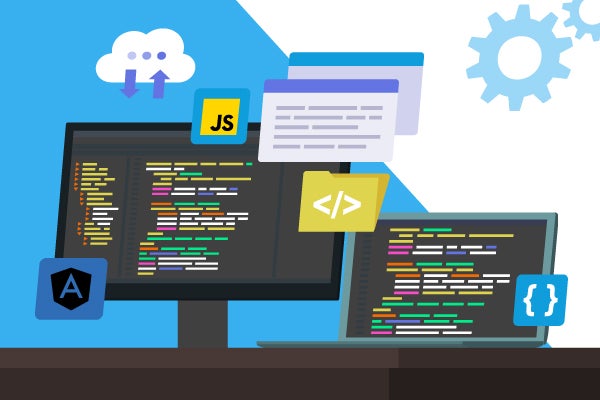
How to Choose a JavaScript Framework to Replace AngularJS
AngularJS has been end of life (EOL) since 2022, and yet more than 20% of large enterprises have not yet migrated to a different framework*. Usually when software becomes end of life, there is a clear successor, but that's not exactly the case with AngularJS.
In this blog, we explore how to choose a JavaScript framework to replace AngularJS, with overviews of the most popular JavaScript frameworks as well as different ways to approach your AngularJS migration.
*Source: 2024 State of Open Source Report
Why Replace AngularJS?
As just mentioned, the main reason to replace AngularJS is because it is end of life. This means no more updates, bug fixes, or security patches are being issued from the community. Staying on EOL software exposes your application(s) to vulnerabilities that can be exploited — resulting in serious fiscal and/or reputational damage that puts your business in the headlines for all the wrong reasons.
Read more about AngularJS vulnerabilities >>
While security is the most important consideration here, it's not the only reason to get off AngularJS. New browser versions and updates to jQuery can also wreak havoc and cause breaking changes and downtime. As an older framework, compatibility is another potential problem. As the web development landscape continues to evolve, there is a good chance AngularJS will not always integrate seamlessly with the latest and greatest tools and libraries.
Back to topKey Considerations for Choosing a JavaScript Framework
In general, assessment in three key areas is important as you evaluate AngularJS alternatives: scalability, community, and learning curve.
Scalability: Scalability should be one of your top concerns when selecting your next JavaScript framework. Think about your project's size and complexity, as well as future plans for growth. You need a framework that can scale as your business scales.
Community: The landscape of JavaScript frameworks has grown over the years, but not every project has been widely adopted or proven stable enough to be viable for enterprise. How established is the community? Can you rely on them for support or guidance if you need it? An active community means there will likely be regular updates, bug fixes, and a robust ecosystem with tools and documentation.
Learning Curve: Before adopting a new framework, it's a good idea to consider how long it will take to learn and your dev team's current expertise. Is your team already familiar with the framework's concepts and syntax? Obviously, choosing a framework that is aligned with your team's existing skills can speed development.
Back to topWebinar: Modernizing Legacy Web Apps: Strategies for a Seamless Journey
Experts from OpenLogic and Zend by Perforce share strategies for modernizing legacy codebases.
Popular JavaScript Frameworks
Let's take a look at a few of the top JavaScript frameworks for frontend development that could be suitable AngularJS replacements. We'll focus on how they compare to AngularJS in terms of architecture, DOM, and data-binding, and highlight some benefits and drawbacks.
Angular
Angular is written in Typescript, which is a superset of JavaScript, so migrating means committing to coding in Typescript moving forward, which may extend the learning curve. Angular does, however, have interoperability with AngularJS, so an upgrade via ngUpgrade is possible. The architecture of Angular is also different from AngularJS: Angular's component-based architecture (compared to AngularJS's model-view-controller, or MVC, architecture) is a better fit for mobile-first development and makes it very scalable, due to reusable modular components that simplify the development of complex applications.
Pros: Extensive list of libraries supported by the core team, very stable, and continually evolving.
Cons: Significant vendor lock-in and extremely difficult to write framework-agnostic parts.
Learn more about Angular vs. AngularJS >>
ReactJS
ReactJS was developed by Facebook and offers a component-based architecture like Angular. While AngularJS is MVC, ReactJS is just V, or View-based, and can be used to build dynamic user interfaces. The biggest difference between AngularJS and ReactJS is their scope: AngularJS is more broad and feature-rich, whereas ReactJS is more narrow in scope, making it lightweight and flexible. AngularJS also relies on the real DOM, which can slow things down compared to virtual DOM frameworks like ReactJS and VueJS.
Pros: Highly flexible and popular, with the option to use other JSX alternatives if needed.
Cons: Despite established best practices, there is no clear consensus on implementation, requiring strong technical leadership to deploy.
Read more about AngularJS vs. ReactJS >>
VueJS
VueJS is known for its versatility and intuitive syntax, making it easy to learn. Like ReactJS, it is lightweight with a small API footprint and focused on the “view” part of the typical MVC architecture. VueJS supports two-way data binding, similar to AngularJS, but discourages it in favor of one-way data flow, which is more flexible. Many developers find it easy to get started with VueJS, but before migrating, be sure to consider how your AngularJS deployments are using behaviors from the AngularJS ecosystem.
Pros: Community-driven framework with excellent developer experience (DX) and a robust ecosystem.
Cons: Transition from Vue 2 to Vue 3 demonstrates that community-driven changes can be challenging to manage and maintain, posing future risks.
Get a more in-depth comparison of AngularJS vs. VueJS >>
EmberJS
Compared to the lightweight simplicity of ReactJS and VueJS, EmberJS is more "complete" and well-suited to complex, high-traffic mobile or desktop applications. It follows the MVVM (model-view-view-model) architecture, and components cannot be reused. Compared to AngularJS's modular approach, EmberJS utilizes routers, templates, models, and components. While two-way data binding is preferred according to the documentation, one-way data binding is also supported. EmberJS uses a rendering engine called Glimmer, which behaves similarly to a virtual DOM.
Pros: Comprehensive, all-in-one framework providing more than necessary to develop single-page applications.
Cons: Declining usage makes EmberJS less resourceful in terms of available solutions.
Explore more differences between AngularJS and EmberJS >>
Back to topPlanning Your AngularJS Migration
Both the choice of framework and migration strategy is likely going to be informed by how you/your stakeholders prioritize quality, time, and cost. In the ideal-but-unlikely scenario that you have unlimited money and unlimited time, you won't have to sacrifice at all in terms of quality. However, most teams will have to make decisions based on tight deadlines and budgets.
Questions to Answer Before Migrating
As with any legacy codebase modernization project, you should start by analyzing things like size, complexity, dependencies, and your dev team's bandwidth. Answering the following questions is a good starting point:
- What are the parts and responsibilities the existing application has? Mainly Views? Controllers or Services that integrate with other pieces?
Which tools and libraries or 3rd party solution does the application rely on?
- Which parts of the existing application can be reused or slightly adjusted?
- By moving to another framework, will there be a new list of technical requirements?
What resources are required to maintain the existing solution stack?
- What resources are needed to execute a migration?
Once you've answered these questions and chosen the framework to replace AngularJS, you're ready to plan the migration itself. There are essentially two approaches:
- A phased migration, aka gradually replacing AngularJS components with the new framework. Depending on your application, this can be technically challenging, but it can be done. It may require partnering with a commercial vendor for long-term support (LTS) for your existing system while you migrate and/or expertise to guide the migration itself.
- A complete rewrite, aka rebuilding the application from scratch on the new framework. This can be both time- and resource-intensive; on the other hand, a rewrite could unlock opportunities for a new version with a different vision.
There are some tools that can help automate refactoring, analysis, and running codemods, including ngMigration Assistant, Jscodeshift, and TSLint. The open source community for your new framework may also be able to offer tips and support, or you could consult with OpenLogic for help building your migration roadmap. OpenLogic also offers AngularJS LTS through 2030 if you need a source for patches while you rewrite or migrate your system.
Back to topFinal Thoughts
Make sure to conduct thorough testing and debugging before implementing the new framework in a production environment, as there may be unforeseen compatibility or integration issues. Also be prepared to offer whatever additional training or upskilling your team needs so they can fully take advantage of the new framework's capabilities. Finally, after migrating, don't forget to continually monitor performance via metrics like page load speed, network requests, and rendering, so you can optimize as necessary to keep your application running efficiently.

Additional Resources
- Webinar - Modernizing Legacy Web Apps: Strategies for a Seamless Journey
- Guide - AngularJS Alternatives and Support Options
- Blog - AngularJS Vulnerabilities: How To Assess AngularJS CVE Severity
- Blog - AngularJS CVE-2024-21490: Are You at Risk?
- Blog - AngularJS CVE-2022-25844: Impact and Mitigation Steps
- Blog - Top Open Source Frameworks from the State of Open Source Report
- Datasheet - Long-Term Support for AngularJS
